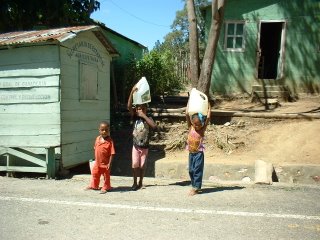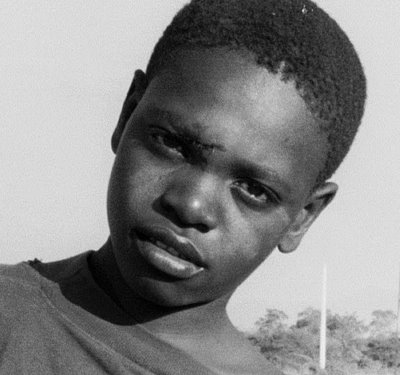
82 among about 110 families in Clavellina have water service to their houses. There’re houses where water come only once~twice a week depending on the location, but having the water facility at home means no need to go to one of the three wells in the community. The only water tank that supply this water through pipes to all the houses in Clavellina broke down two weeks ago, due to a thunder shock.
“Agua es sangre del campo (water is blood of countryside),” told me an old man. Without water, there’s no agriculture, no living.
My house’s water consumption is relatively small as I live alone and I am out during the day. I also have a luxurious option of going to my apartment in Dajabón (town) to take shower, if not in the river. So the water in the big bucket that I always keep full lasted for a while. But it emptied on Friday.
Saturday morning, my neighbor woman, Ayalibis, and I went to the nearby well to get water (by the pick-up truck). There was a crowd of people—an old lady with many small bottles, boys who came with donkeys, etc. Ayalibis and I pumped water from the well, throwing such words as “que buen ejercicio!” “nos mantiene joven!” “eso pone senos duros!” (“what a good exercise!” “it keeps us young” “keeps busts firm!”)… By the way, this well was made by the Japanese government in 1995.
The next day, we had a rain after a long dry period. As soon as the rain drop started to fall, I took out buckets and containers outside the house, as learned from the neighbors. When I came back to my house in the evening, I got excited seeing the buckets half filled with rain water. I thought, "I wouldn’t have known this sort of small joy if I hadn’t lived in the village..." Maybe it was hidden behind my decision to move to the village.
水
クラベジーナ村の110家族ほどのうち、82家が水道を持っている。家の立地条件によって水が来るのは週1~2回の家もあるが、家に蛇口があるぶん、村に3つある井戸まで水汲みに行かなくてすむ。この水道水の出所である、村にある唯一の水タンクの部品が、2週間前、雷で故障した。
「水は田舎の血じゃあ」とあるおじいさんが言っていたけど、水ほど必要なものはない。電気はなくてもある程度生活できるけど、水がなければ生活できない。
私は一人で住んでいて水の消費量は少ないし、日中は外に出ていて街にアパートもあるから、しばらくは溜めてあった大バケツの水でもったのだが、とうとう水がなくなってしまった。
土曜の朝一、お向かいのアヤリビと、ミニトラックで(トラックで水汲みに来る人なんて私くらい)近くの井戸まで水汲みに。井戸には小さいボトルをいくつも抱えたおばあさんや、ロバと一緒に水汲みに来た男の子らが群がっている。アヤリビと「いい運動!」「腹筋が鍛えられる!」と言い合いながら、井戸のハンドルを上下に動かし、水を汲んだ。ちなみにこの井戸は1995年に日本政府が掘ったものらしい。これほど使われている日本の贈り物も少ないのではないかと思うほど、この井戸は四六時中働いている。
翌日久しぶりに雨が降った。大急ぎで家にある洗面器等を外に出す。しばらく外出して家に戻り、洗面器やバケツに半分くらい水が溜まってるのを見た瞬間、嬉しくなった。こんな小さな喜び、ここに住まないと味わえなかっただろうなあ。村に引っ越そう、と思った背景に、こういう喜びも隠れていたのかもしれない。
写真:水汲みは子どもの仕事。Guayajayucoという山村にて。
Photo: The children walk back and forth to bring water home. In the mountainous Guayajayuco.

 Pointing at the scar by his right eye, he asked for a peso (3 cents). My silent voice asked, “why only one peso? You can’t do anything to your scar with one peso. Why can’t you ask for a bit more?” I felt contradictory thinking so while denying his act of begging.
Pointing at the scar by his right eye, he asked for a peso (3 cents). My silent voice asked, “why only one peso? You can’t do anything to your scar with one peso. Why can’t you ask for a bit more?” I felt contradictory thinking so while denying his act of begging.



